Hundreds of planets, hundreds of quests, but is there anything worth seeing?
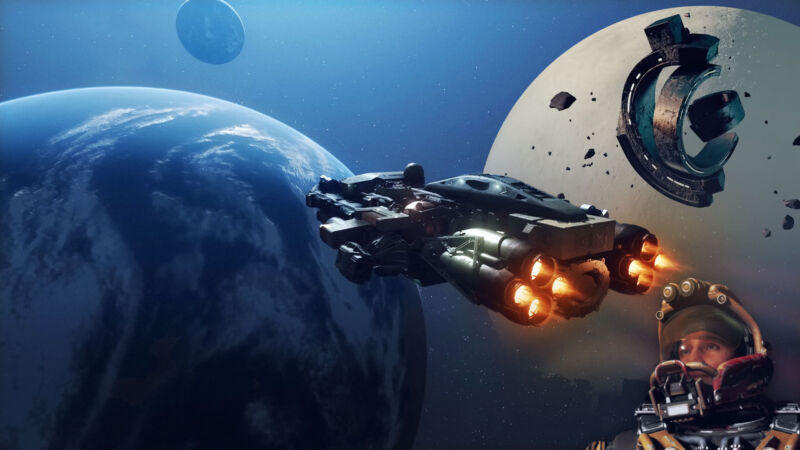
Bethesda | Aurich Lawson
Game details
Developer: Bethesda Game Studios
Publisher: Bethesda Softworks
Platform: Windows (reviewed), Xbox Series X/S
Release Date: Sept. 6, 2023 (Aug. 31 early access)
ESRB Rating: M for Mature
Price: $70 (included with Microsoft Game Pass)
Links:
Amazon |
Steam |
Official Website
There's a quote from Douglas Adams' The Hitchhiker’s Guide to the Galaxy that I’ve been thinking about a lot lately. “Space is big,” he writes. “You just won't believe how vastly, hugely, mind-bogglingly big it is. I mean, you may think it's a long way down the road to the drug store, but that's just peanuts to space.”
Starfield may as well put this quote on the cover page of its design document. The deafening prerelease hype for the game emphasizes its inclusion of “over 1,000 planets,” across hundreds of realistically rendered star systems throughout the galaxy. That promotion has also focused on just how much stuff there is to do across those myriad planets; Bethesda Head of Publishing Pete Hines said in a recent interview with IGN that he’s spent 150–160 hours in the game and “hasn’t even come close” to seeing everything.
After a few dozen hours with a prerelease version of Starfield, I’m comfortable saying that Hines isn’t being hyperbolic. One look at the game’s intricate star map and the myriad star systems you can reach with a series of warp-speed jumps is enough to give you vertigo.
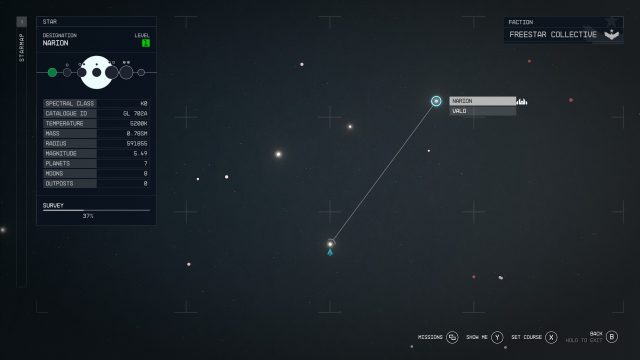
Just a small corner of Starfield's massive star map.
If you can focus on Starfield’s “core story” questline, which focuses on a collection of mysterious, vision-granting Artifacts strewn across the galaxy, you may well be able to reach the “ending” of the game in a reasonable amount of time. If you’re anything like me, though, you’ll find yourself quickly sidetracked by a cornucopia of optional missions that start to grow almost fractally, with each new quest flowing into offers of multiple further quests along the way.
Many of these missions are one-off simple tasks that can be completed in short order (an inordinate number of Starfield NPCs have been stiffed by some no-show pilot or another). But many more are the start of full-fledged careers, each with a seemingly never-ending series of errands that will send you bouncing back and forth between far-flung planetary systems.
Within a few hours of starting the game, I found myself engaged as a pilot in the Vanguard Navy, working as a (semi-unwilling) undercover agent for a System Defense group and taking on freelance bounty-hunting jobs. And that’s all in between answering distress calls, doing cargo runs, tracking down an electrical drain in a subterranean community, and countless other odd jobs.
The bigness of Starfield (and of space in general) isn’t up for debate. The key question, as it is in the Hitchhiker’s Guide books, is how to go about finding something interesting to do in all that space. And on that score, thus far, Starfield has been more of a mixed bag.
1,000 planets and not much on
Some expectation-setting is important here. Just because Starfield boasts over 1,000 planets, don’t go in thinking you’re getting 1,000 fully realized, Skyrim-level civilizations unto themselves. First off, a lot of the planets are gas giants that you can explore from orbit but not land on (though it’s not clear if those even count in Bethesda’s 1,000-plus number). But even for the rocky planets you can land on, a random “off the beaten path” sampling seems more likely to yield a large, mostly barren landscape than a world bursting with life. Even good-old Earth is subject to this rule, as the planet was made desolate years before the game's events by the environmental catastrophe that first sent humans to the stars.
To be fair, you can get lucky and pick a random location full of lush vegetation and colourful fauna. I stumbled on one full of large, grazing beasts alongside carnivorous dinosaurs that wouldn’t look out of place in a natural history museum diorama.
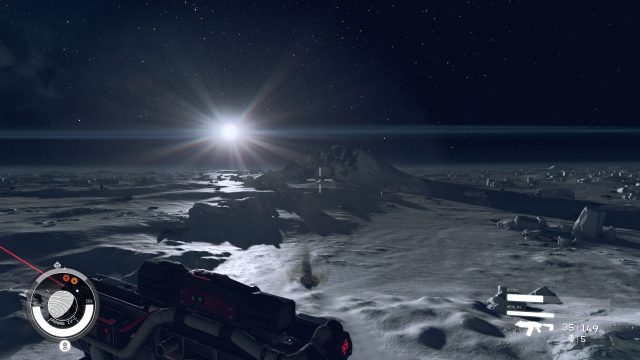
"Another dead rock."
Thus far, though, most of Starfield’s sprawling galaxy seems taken up by much less lively planets. My computer-controlled partner put a fine point on this during a random exploratory visit to one of these locales. “Another dead rock,” she said as we disembarked. “Well, at least we can scour it for materials.”
To be fair, even on the deadest of planets, your hand scanner will likely pick out a handful of points of interest that initially show up as “unknown” features, often a few hundred meters distant from your landing site. And you can definitely spend a minute or two trudging past the odd crater to get to them, bouncing through the air with a back-mounted boost pack to pass the time.
If you do, you might find a cave filled with bioluminescent fungus, an abandoned outpost being ransacked by pirates, or a downed ship that you can steal after killing its crew (hilariously, the dead bodies from that encounter are still hanging around my cockpit as I travel the stars, with no apparent way to remove them). You might even stumble on a self-contained micro-story: a group of stranded miners that need a lift off the planet or corpses that have been messily devoured by hordes of slug-like aliens (and look out—they’re still hungry).
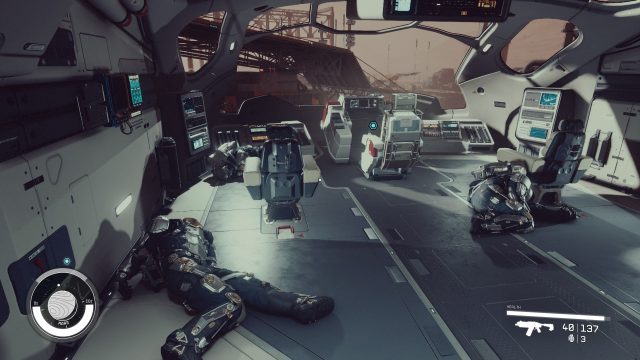
For the life of me, I can't figure out how to get these dead bodies off my stolen ship.
Even without 160 hours devoted to the game, though, these procedurally generated encounters are already starting to feel kind of repetitive. Once you’ve stumbled on one automated mining facility whose robots react negatively to your presence, you’ve pretty much seen them all. Even mining for the scattered bits of raw elemental material on these planets starts to feel like a waste of time once you realize you can buy that same material for a relative pittance of in-game currency.
So yes, you can definitely find something to do by just picking a point on Starfield’s map and indulging your wanderlust. Just don’t expect that kind of wandering to result in No Man’s Sky levels of wondrous discovery most of the time.
A sea of humanity
What Starfield lacks in random planet-hopping, it more than makes up for in the “core” planets where you’ll be assigned and complete most of the game’s myriad quests. There’s a staggering level of detail put into the major cities, settlements, and colonies of these carefully crafted hub worlds. That’s especially apparent in the architecture, from sprawling retro-futuristic walkable cities to bustling commercial trade hubs to subterranean mines crowded with the dregs of society, and everything in between.
Beyond the buildings themselves, the highly varied human scenery gives these planets a sense of liveliness that’s often missing from space exploration sims. A short walk between buildings will see you passing dozens of passersby in all shapes and sizes. Many of these NPCs are only equipped with a single line of dialogue, but a surprising number will engage in a full-fledged back-and-forth conversation if you so much as say “hi.”
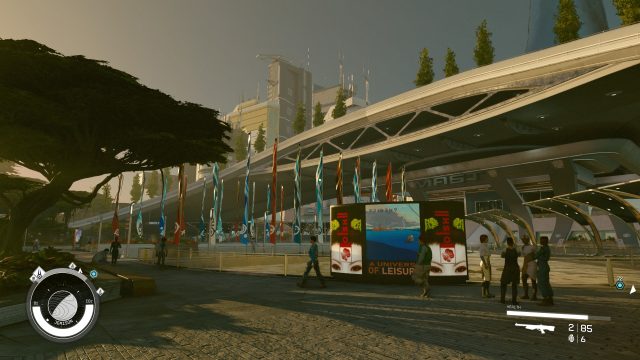
Not every citizen has a story to tell, but a surprising number do.
Speaking of which, I hope you’re in the mood for a lot of chatting. A large amount of my time in Starfield thus far has been spent not exploring the galaxy but in a monotonous conversation interface, staring head-on at an NPC while they talk my ear off about some problem.
You can speed through the captions and skip through the spoken dialogue to save some of this conversation time, but that would deaden the impact of the sharp writing and usually well-delivered voice acting (even random shopkeepers end up often conveying a lot of character through small gradations in accent, tone, and cadence). Then again, skipping through also limits your exposure to incredibly stiff motion capture and lip-syncing that makes every character look a bit like a Disney animatronic. The overall effect falls deep in the uncanny valley, especially in the not-uncommon situations where a character’s gaze or body language gets stuck facing away from you.
More than that, the large amount of time spent staring down literal talking heads from an unchanging first-person perspective makes for a relatively unengaging “tell, don’t show” storytelling style. There were points in these endless conversations where I found myself yearning for a quick camera angle change, a cut scene, or even a Rockstar Games-style “talk while traveling from point A to point B” info dump.
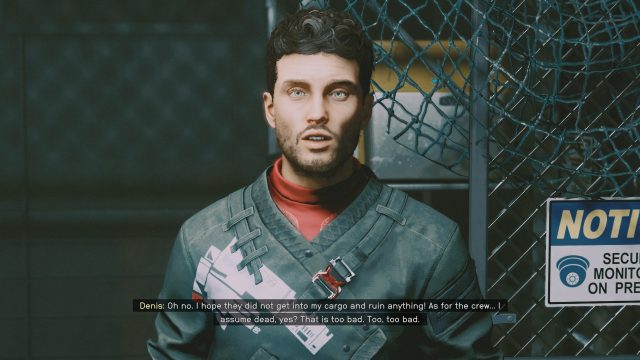
Get ready to spend a lot of time staring at dead-eyed talking heads like this.
When you get to talk back to these floating heads, most conversations don’t seem to branch so much as flow into short tributaries that quickly merge back into the same main river, regardless of your choice. Your conversation partner will answer the tone of your chosen response (snarky, self-assured, cynical, etc.) with an appropriate contextual response, then go right back to what they were obviously planning to say anyway. Your computer-controlled partner might express some moral qualms about a particular response chain, but thus far, that hasn’t had much noticeable effect on any gameplay outcomes.
As for the content of those conversations, it’s been heavy on the expositional “universe building” side and relatively light on the “character building” side. That’s not an entirely bad thing; you can really sense the care the Starfield team has put into building the backstory and history of humanity’s star-faring future. It’s been fascinating learning about the massive war that split humanity into three barely tolerant factions and the incompatible philosophies behind how those factions live their lives. But I also can’t say I’ve developed a close attachment to even the major characters I’ve encountered thus far, who have tended toward paper-thin motivations and relatively cliched personality types (the science nerd, the true believer, the money man, etc.).
Performance
Given Bethesda's history with open-world games, it's fair to worry about technical issues popping up in the launch version of Starfield. Surprisingly, though, such problems have been minimal in my time with the game. There were only a small handful of noticeable frame rate hitches, conversation partners looking in the wrong direction, and characters getting temporarily stuck in scenery or doorways. There were also more than a few instances where a background character kept loudly chattering while I was trying to converse with someone, but to be honest I can't be 100 percent sure that wasn't intentional.
There is one technical annoyance built into the game's structure, though: loading. Hopping from one star system to another can require a lot of explicit transitions, from planet to ship to orbit to the new star system and finally to the new planet's surface. Most of those transitions include a short bit of loading, which breaks up the experience just enough to make the vast, interconnected galaxy feel a bit like a disjointed set of unrelated planets.
What would you do?
Aside from NPC chatter and random planetary exploration, the actual quests in Starfield break down into a few broad categories. For me, the most engaging of these by far has been the space-based ship-to-ship battles. The main strategy in these dogfights involves managing your speed and angle to maneuver your ship behind or astride the enemy so your forward weapons can lock onto them without them locking onto you.
After that, unloading your various energy weapons and missiles is more a matter of energy management than precise aim. On top of all that, juggling the ship’s limited power supply between shields, engines, and weaponry on the fly (while also ordering necessary hull repairs when needed) made me feel more like a Star Trek captain than most actual Star Trek games I can think of.
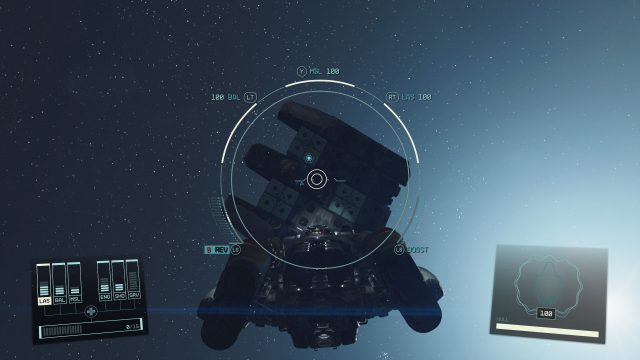
Getting the drop on an enemy from below? It's easy in zero gravity.
Ground-based enemy engagements are a little less... well, engaging. That’s largely thanks to enemies that have an annoying tendency to simply stand out in the open and absorb incoming fire, interspersed with a few damage sponges that charge at you with close-quarters attacks instead. Even a set of massive, fearsome, supposedly city-destroying beasts you encounter in one questline can be pretty easily manipulated by hiding behind a wall and then doubling back after a few quick shots.
On the plus side, using your boost-pack to double- or triple-jump around some of the more vertically oriented battle locations brings to mind the more acrobatic portions of Bethesda’s own Doom reboot (though in a much less frenetic fashion). And the game provides various weapon types that each feel suitably impactful.
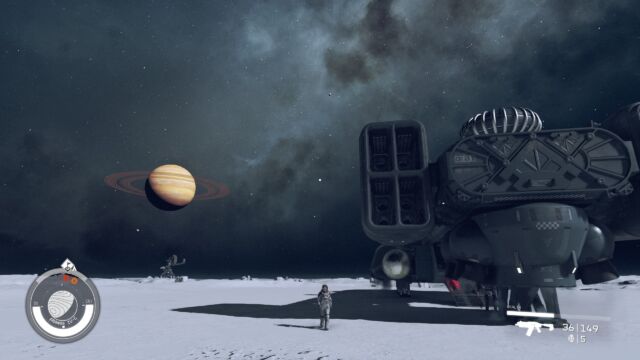
Starfield has some breathtaking vistas if you know where to look.
There are some major questlines where these action-oriented encounters are practically unavoidable, though loading up on med packs or ship parts can help even reflex-deficient players brute force their way through most battles. But there are also a lot of questlines that go out of their way to suggest and even encourage less lethal means to get to the same goal. That can mean rolling the (virtual) dice in an attempt to persuade a hostile human, stealthily infiltrating a location without being seen, or simply paying your way out of a situation with extra money earned from other encounters. Which path you choose depends heavily on which of the wide menu of new skills you choose to focus on as you level up (including quite a few that can help you become a criminal mastermind if you so choose).
And then there are the subsystems underlying these major gameplay systems. Mined resources can be put into research projects (which teach you how to craft your own items), into mods for weapons and spacesuits, or even into sprawling, resource-extracting outposts on far-flung planets. Those with more in-game money can trick out their ships (and even choose the location of their new snap-on parts) or eventually buy and outfit property in a hub city or habitat modules away from it.
I haven’t spent much time examining these subsystems, largely because buying (or mining) and carrying around the necessary elemental resources so far feels like more trouble than it’s worth. I’ve spent an inordinate amount of time simply juggling a huge amount of carryable junk between my backpack, my computer-controlled partner’s backpack, and the hold (and floor) of my growing fleet of ships. Virtual hoarders, beware—you’re committing to a veritable lifetime of inventory management menus and tough decisions about what to drop before you return to the ship.
Despite the gripes I’ve mentioned above, I’ve still found it startlingly easy to fall deep into Starfield’s (just-short-of-literal) galaxy of pure content. That fractal quest design pattern makes it very compelling to stretch out a play session for “just one more jump” until you look up and suddenly it’s three hours past when you planned to sleep.
I’m not sure if that loop will be strong enough to push me up to and past the 150-hour mark. One thing is clear, though; if we have to wait another eight years for a Fallout 4-scale single-player adventure from Bethesda Game Studios, Starfield has enough raw content to keep a certain type of space-fiction-obsessed player plugging away for a good chunk of that wait.
Source





3175x175(CURRENT).thumb.jpg.b05acc060982b36f5891ba728e6d953c.jpg)






Recommended Comments
There are no comments to display.
Join the conversation
You can post now and register later. If you have an account, sign in now to post with your account.
Note: Your post will require moderator approval before it will be visible.